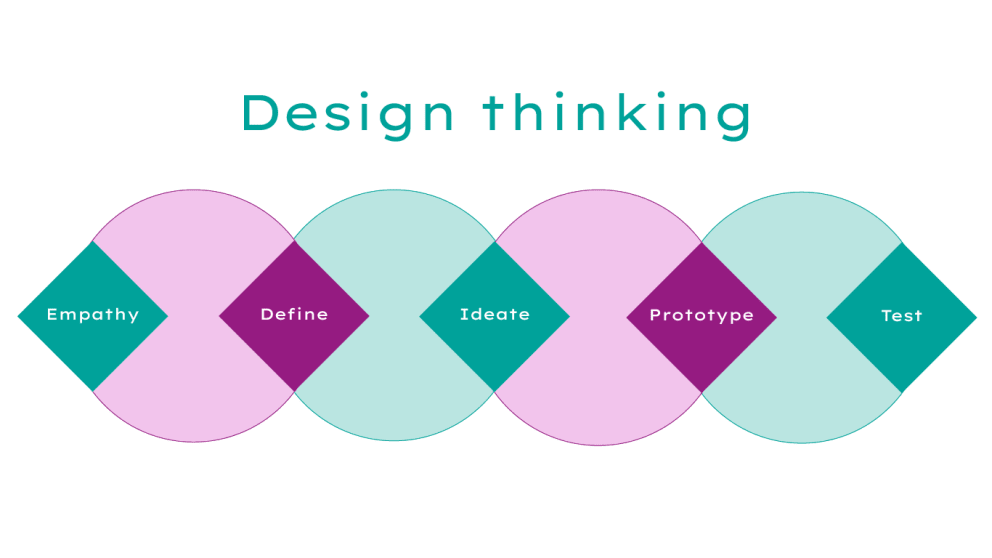Design Thinking in 2024: A Refresher on the Essentials
Design thinking has become an essential tool for businesses navigating the ever-changing world of design and technology. A while back, our DUX team at Amazee Labs explored the core principles of this transformative process in an article titled "Design Thinking at a Glance." While design trends and technological advancements move at a rapid pace, the fundamental principles of design thinking – understanding users, generating creative solutions, and carefully testing those solutions – remain as relevant as ever.
In this article, we'll revisit the evergreen design thinking process, taking a fresh look into each stage and exploring how it can be applied to tackle modern design challenges. Whether you're a seasoned designer or just starting out, this refresher will equip you with the tools you need to unlock innovative solutions that truly resonate with users.
What is design thinking?
Design thinking is a user-centred approach that helps designers create innovative solutions to real-world problems. It involves understanding user needs, generating creative ideas, and testing solutions through a flexible and iterative process. This approach focuses on finding solutions that are not just functional but also meet people's emotional and practical needs.
Why is design thinking important?
Design thinking is a very collaborative process that helps businesses innovate and stay competitive. By focusing on understanding user needs and working across different departments, teams can develop solutions that not only meet those needs but also create new opportunities.
At Amazee Labs, we employ a design thinking approach, rooted in the Hasso Plattner Institute of Design’s five-stage model: empathise, define, ideate, prototype, and test. This customer-focused methodology allows us to create innovative solutions tailored to our client’s specific needs.
In this article, we’ll delve into each stage of this transformative process.

1. Empathy:
Empathy is the cornerstone of successful design and to truly understand our users, we must first walk in their shoes. The empathise stage involves immersing ourselves in their world, observing their interactions, and gaining insights into their experiences. By deeply understanding users' needs, challenges, and behaviours, designers can create products and services that truly resonate.
This knowledge empowers us to develop solutions that not only meet functional requirements but also exceed user expectations.
2. Define:
The define stage is where we transform our user insights into actionable problems.
At this stage, we start to shift our attention from observing user behaviour to identifying the specific challenges that prevent them from achieving their goals. This clarity is crucial for guiding the design process towards effective solutions. By synthesising our observations from the empathise stage, we create a clear problem statement that guides the design process.
A problem statement is a clear and concise description of the challenge you aim to solve. It's derived from the insights gathered during the empathise stage and serves as the foundation for the design process. It acts as a compass, directing our efforts towards solutions that truly meet user needs.
3. Ideation:
Ideation is the creative heart of design thinking.
This essential step in the design thinking process is where we brainstorm and generate a multitude of ideas to address the problem identified in the define stage. This is the phase where we encourage wild, unconventional thinking to explore all possibilities.
Techniques like brainstorming, mind mapping, and sketching can be used to generate a wide range of possibilities. The key to successful ideation is quantity over quality at this stage, fostering a judgment-free environment where diverse perspectives can flourish.
4. Prototyping:
Prototyping is where ideas take shape.
This stage involves creating tangible representations of our concepts to test and refine them. Whether it's a simple paper sketch or a fully interactive digital model, prototypes help us understand how users will interact with our designs. By gathering feedback and making adjustments, we can iterate and improve our solutions, ultimately improving our connection with users.
5. Testing:
Testing is the crucial final step in the design thinking process.
By observing how real users interact with prototypes, we gain invaluable insights into the product's strengths and weaknesses. Popular methods of testing include usability testing, A/B testing, user surveys and heuristic evaluations; all of which are consistently employed by our teams at Amazee Labs.
Testing creates a feedback loop, which allows us to identify and address usability issues early on, saving time and resources while enhancing the overall user experience.
Takeaway
Design thinking is all about putting people first. It's a creative problem-solving approach that helps us understand user needs, challenge assumptions, and design solutions that are not just functional, but also creative. It's like being a detective, but instead of solving mysteries, you're finding the best ways to meet people's needs through design.
Discover how Design Thinking can transform your business and unlock its full potential. Our team of UX experts at Amazee Labs can guide you through this innovative process. Get in touch with us to learn more.